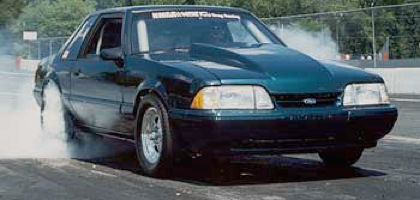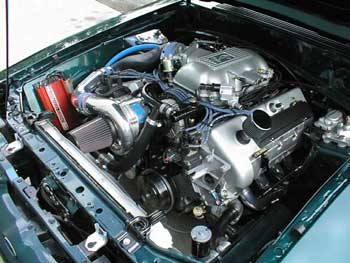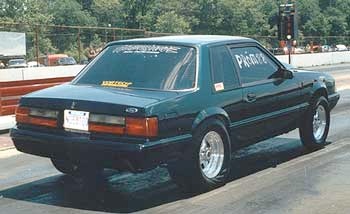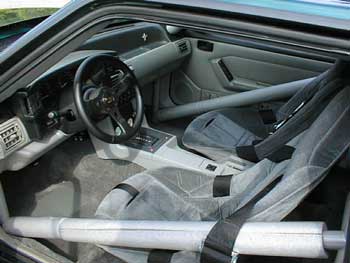10 Inside Our 9 Second DOHC 32V (stock Pistons And All!)
Inside Our 9 Second DOHC 32V (stock pistons and all!)
Monday, July 10, 2000

Since this car has been receiving so much attention (and controversy) lately, we’ve decided to do a full write up on it. When we first debuted this car earlier this year, many people couldn’t believe that a stock DOHC 32V was capable of performance like we were finding, especially not with the stock hyperutetic pistons.
The car is a ’91 coupe that was purchased rolling without an engine or transmission and is owned by “Turbo Joe” Spiteri, a long time customer who also owns an 11 second 84 1/2 GT turbo 4 cylinder, thus the nickname. It was treated to a fresh coat of its original emerald green and a new interior. Other than a 3″ Fibertrends hood the body is stock. Being intended for primarily track duty, the car is gutted but still sports power windows and weighs in at 2980 lbs. with driver.
We set out to build this car to show people how well a stock 32V engine can run and how reliable the factory components (especially the hyperutetic pistons) really are. In short, the car has exceeded our expectations and we couldn’t be happier.

The heart of the car is a 32V DOHC engine with 18,000 miles, courtesy of a ’97 Cobra. The only modifications to the engine itself was the removal of the IRMC plates and the factory springs were shimmed .060″ to increase pressure and valve stability over 7500 rpm. As for engine modifications, that’s it. There is no headwork, the cams are stock and WE’RE USING THE STOCK HYPERUTETIC PISTONS. The long block has not been apart, and it has been the same engine all along.
Making this little 32V really perform is a Vortech S-Trim supercharger. The S-trim makes an impressive 21-psi at 8000 rpm when the car crosses the finish line. Of course to support this kind of boost and horsepower we needed to supply the engine with plenty of fuel. A Cartech pickup sits in the fuel tank and feeds a 150 g.p.h. Weldon fuel pump. The Weldon pump sends VP C-16 race fuel through #8 line to the stock fuel rails and 55 lb. injectors. Yes, that’s right “stock fuel rails”. They’re completely suited to this kind of application; it’s the stock pump and line that are the bottleneck.
While we work with custom EEC programming everyday, we knew that we wanted more precise control over the engine and opted for the extremely powerful and flexible Speed-Pro fuel injection system. Unfortunately, the Speed-Pro system has received an undeserved reputation for being difficult to program and a “race-only” unit. In fact the Speed-Pro system allows this engine to idle and run as smoothly as a stocker does. It also has a data-logging capability with wide-band air/fuel monitoring that has been very useful to us in tuning the car. We see this EFI system as the perfect solution to serious mod applications, especially when stuck with the new “return-less” fuel systems.
The headers are custom-built units that feature 1 7/8″ primary tubes that step up to 2″ and then into 3″ collectors. The exhaust system is all 3″ and dumps just before the axle. The mufflers are the tried-and-true Flo-Master 3-chambers. We opted for the increased noise reduction qualities of the 3-chambers since this car sees a fair amount of street use. It can often be seen driving around the local cruise spots like Gratiot Ave. As we said earlier, despite its impressive performance, the car remains very street-able.

Transferring power to the rear end is a Ford 4R70W over-drive automatic, which is also a used take-out that is not rebuilt or modified internally. It uses a Performance Automatic trans-brake / valve-body. The transmission is set to shift automatically with the help of the Baumannator Transmission Control System. We cannot say enough good things about the Baumannator and did a full Water Box on it a while back. The Baumannator’s shift timing is so accurate that the car doesn’t even have an after-market tach. The stock tachometer works well enough as a visual reference at idle and during a run. We tune the shift points by programming the Baumannator with a laptop after reviewing the Speed-Pro’s data log report. The converter is a Precision Industries Stallion that stalls to 4000 rpm, which we suspect is a little too tight for an engine that wants to rev and rev.
The car’s suspension is just as straight forward as its engine combination. The frame rails are tied together and a NHRA legal 10-point roll cage keeps the driver safe and the car from twisting during hard launches. The rear suspension finds traction from the aid of Mega-bite upper and lower control arms and an airbag in the right rear factory V8 springs and Koni shocks. The stock rear sway bar was left on and is connected to an 8.8″ rear with 4.56 gears, an Auburn differential and 31 spline axles. The front suspension uses a Griggs tubular K-member modified to fit a 4.6 engine in a Fox body and has unique motor mounts, which allow for the large tube headers. The A-arms are also tubular Griggs units and a front coil-over spring set-up uses Koni drag struts. This suspension set-up has netted a best 60-ft. time of 1.32 with good track conditions.

As of this writing the car has made 54 runs with the majority of them being in the 9.99 – 9.70 range and several hundred street miles in addition to the 18k already on the clock. The very best ET and MPH so far is a 9.67 @ 139.5 and this run was not our best 60-ft. With better track conditions the car is fully capable of a 9.50 as it currently sits. But it won’t be sitting for long. In the next few weeks the car will be receiving a Vortech After-Cooler, a T-Trim supercharger for more boost and a looser converter. We’ll keep you posted on the differences these further refinements make.
Our goal is to finish the 2000-racing season with a very low 9-second time slip, all without any internal modifications to the engine. Head porting and new cams may be in the cards next year. At this point we feel that we have proved beyond a doubt that the stock hyperutetic pistons can stand up to more horsepower than many people think. As we’ve always maintained, proper and conservative tuning is the key to ensuring a long life for your engine.
July 17 2000
Update – Vortech Aftercooler Results
As we promised, we’re providing an update of our results with the Aftercooler upgrade. Without any other changes to the current combination, we added Vortech’s water-cooled intercooler for the DOHC 32V.
The results were disappointing. We knew the cooler was kind of small for the high boost levels we’re attaining and that it would kill a little of the boost, but we had hoped the cooler discharge temps would have outweighed the lost boost. As we expected, the Aftercooler killed 4 psi of boost, but it also lowered our discharge temps by almost 100° F at the end of the track.
We took the car to the Fun Ford event at Norwalk Raceway. With some minor tuning changes to adjust for the Aftercooler the car only ran a 10.14 and a 10.15 both at 136.5 mph. As with most events where there are plenty of street cars with radial tires, the track wasn’t hooking well. Our best 60 ft. of the day was only a 1.56. We normally run in the mid 1.30’s. If the car was hooking better it would have dipped back into the 9’s. And we may have been able to get more aggressive with the tuning and return the car to it’s usual 9.70’s and 60’s. But we refuse to put this engine on the ragged edge, we want to show people that the stock pistons can hold up just fine and it takes conservative tuning to accomplish this. So the Aftercooler didn’t work out on this combination and will be coming off in the next few days.
We’ll be attending the Cyber-Brawl sans Aftercooler but with a T-Trim for more boost and a larger volume of air. We’ll let you know how it works out.
Our 9 Second Car.
